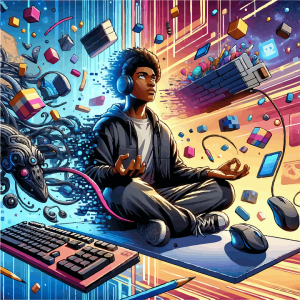The Future of Web Design: Trends to Watch in the Next Decade
Web design has evolved significantly over the years, shaped by technological advancements, changing user behaviors, and the rise of new tools and platforms. As we step into a new decade, the future of web design promises to be more dynamic, inclusive, and innovative than ever before. Designers will need to adapt to new trends that prioritize user experience (UX), accessibility, and cutting-edge technology. In this blog, we’ll explore the key trends likely to dominate web design in the coming years.
AI and Machine Learning in Web Design
Artificial intelligence (AI) and machine learning (ML) are no longer just buzzwords in the tech industry; they are becoming integral to web design. AI-powered tools like chatbots, personalized content algorithms, and design automation software are reshaping how websites are built and how they interact with users.
- AI-driven personalization: Websites will increasingly leverage AI to provide tailored user experiences. For instance, e-commerce platforms can use AI to recommend products based on a user’s browsing history and preferences.
- Design automation: Tools like Wix ADI and Adobe Sensei already use AI to automate web design, enabling faster and more efficient creation of websites without compromising quality.
- Chatbots and virtual assistants: AI chatbots will become more advanced, providing instant, human-like customer support and improving user satisfaction.
Voice User Interface (VUI)
With the growing popularity of smart speakers like Amazon Alexa, Google Home, and Apple’s Siri, voice search and interaction are becoming mainstream. Voice user interfaces (VUIs) will transform web design as websites adapt to accommodate voice-activated commands.
- Voice-optimized design: Websites will need to ensure that content is structured in a way that aligns with how people speak. This includes prioritizing natural language processing (NLP) and optimizing for voice search queries.
- Accessibility benefits: VUI can enhance accessibility for users with disabilities, making web experiences more inclusive.
Immersive Experiences with AR and VR
Augmented reality (AR) and virtual reality (VR) have already made a splash in gaming and entertainment. The next decade will see these technologies become more prevalent in web design, offering immersive experiences to users.
- AR in e-commerce: Imagine trying on clothes virtually before making a purchase or visualizing furniture in your living room through an e-commerce website.
- VR for training and education: Websites for online learning and corporate training can leverage VR to create engaging, interactive modules.
- 3D design elements: AR and VR integration will also drive the use of 3D graphics and animations to enhance visual storytelling.
Minimalism and Dark Mode
Minimalist design has been a dominant trend for years, but it will evolve further to focus on functionality and clarity. Meanwhile, dark mode is here to stay as users increasingly prefer this eye-friendly and battery-saving option.
- Content-first design: Minimalist websites will prioritize content over flashy visuals, with clear typography and ample white space.
- Dark mode: Offering dark mode options will become a standard feature, providing users with a choice to reduce eye strain and enhance readability in low-light environments.
- Color contrast: Dark mode design will require careful attention to color palettes to ensure readability and accessibility.
Focus on Accessibility and Inclusivity
As awareness of digital accessibility grows, web design will increasingly prioritize inclusivity. Ensuring that websites are usable by people with disabilities is no longer optional but essential.
- WCAG compliance: Designers will adhere to the Web Content Accessibility Guidelines (WCAG) to create accessible websites.
- Inclusive design: This involves considering a diverse range of users, including those with visual, auditory, cognitive, or mobility impairments.
- Keyboard navigation: Websites will be optimized for keyboard-only navigation, ensuring usability for individuals who cannot use a mouse.
Progressive Web Apps (PWAs)
Progressive Web Apps (PWAs) combine the best of web and mobile apps, offering users a seamless experience across devices. PWAs are fast, reliable, and engaging, making them a preferred choice for businesses and developers.
- Offline functionality: PWAs can work offline or with limited connectivity, ensuring a smooth user experience.
- App-like features: They can be installed on devices and support push notifications, blurring the lines between web and native apps.
- Cost-effective development: PWAs eliminate the need for separate web and mobile app development, reducing costs and complexity.
No-Code and Low-Code Development
The rise of no-code and low-code platforms is democratizing web design, enabling non-developers to create functional websites and applications. These tools will continue to gain traction, fostering creativity and reducing development time.
- Empowering creators: Platforms like Webflow, Squarespace, and Bubble allow designers and entrepreneurs to bring their ideas to life without extensive coding knowledge.
- Rapid prototyping: No-code tools facilitate quick prototyping, making it easier to test and iterate on designs.
- Collaboration-friendly: These platforms often include built-in collaboration features, streamlining communication between teams.
Dynamic and Interactive Content
Static content is becoming a thing of the past. Users expect dynamic, interactive content that responds to their actions and preferences.
- Micro-interactions: Small, subtle animations like button hover effects and loading spinners enhance the user experience.
- Interactive storytelling: Websites will use scroll-based animations and parallax effects to engage users with captivating narratives.
- Gamification: Adding game-like elements such as badges, rewards, and progress bars can make websites more engaging and fun.
Eco-Friendly Web Design
As concerns about climate change grow, sustainable web design will become a priority. Websites will aim to reduce their environmental impact by optimizing performance and minimizing energy consumption.
- Lightweight design: Reducing the size of images, videos, and other assets will decrease loading times and energy usage.
- Green hosting: More websites will choose eco-friendly hosting providers that use renewable energy.
- Efficient coding: Clean, efficient code can significantly reduce a website’s carbon footprint.
Hyper-Personalization
Personalization will reach new heights, driven by advancements in AI and data analytics. Users will expect websites to anticipate their needs and deliver highly relevant content.
- Behavioral analytics: Websites will analyze user behavior in real-time to offer personalized recommendations and experiences.
- Dynamic content: Content will adapt based on factors like location, device, and user preferences.
- Ethical data practices: As personalization relies on user data, websites will need to prioritize transparency and consent to build trust.
Conclusion
The future of web design is bright, with endless possibilities driven by technological innovation and a deeper understanding of user needs. From AI-driven personalization to immersive AR/VR experiences, the trends outlined above will shape how websites are designed and experienced in the next decade. Designers and developers who embrace these changes and prioritize user-centric design will be well-equipped to create websites that are not only visually stunning but also functional, inclusive, and sustainable.
As the web continues to evolve, one thing remains constant: the need for creativity and adaptability. By staying ahead of trends and focusing on delivering value to users, web designers can play a crucial role in shaping the digital landscape of the future.




